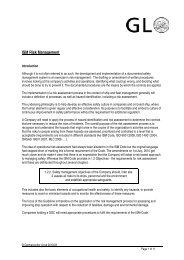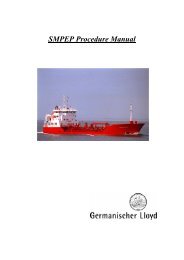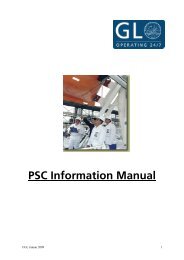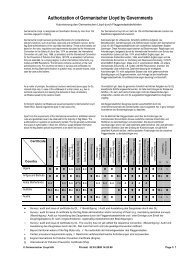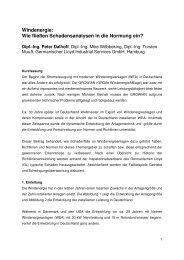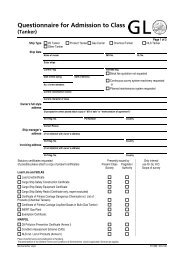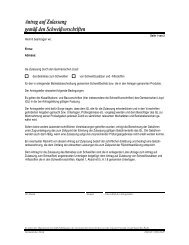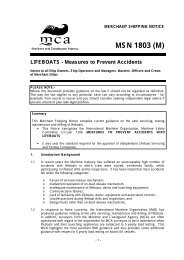Yards Moving Forward - GL Group
Yards Moving Forward - GL Group
Yards Moving Forward - GL Group
Create successful ePaper yourself
Turn your PDF publications into a flip-book with our unique Google optimized e-Paper software.
Systematic Maintenance<br />
Pays Off<br />
With a certified Planned Maintenance System, shipping companies can reduce the<br />
surveying effort for their ships to a minimum.<br />
Port State Control, class surveys, inspections by underwriters<br />
and charterers – small wonder that ship managers<br />
often get the feeling that life consists mainly of checks and<br />
controls. For the class surveys at least, there has for several<br />
years now been the possibility of limiting the number of<br />
physical surveys to a minimum. The key to this is ensuring the<br />
systematic planning and monitoring of the maintenance jobs<br />
in accordance with the requirements of the manufacturers<br />
and classification society. With a certified “Planned Maintenance<br />
System” (PMS), the servicing tasks carried out by the<br />
ship’s own staff on machinery and electrical installations are<br />
recognized as being equivalent to the periodical surveys of<br />
Germanischer Lloyd. The result: the routine surveys for retention<br />
of class can be shortened considerably, leading to a<br />
reduction in lay times and hence also to a lower loss of earnings<br />
over the entire lifetime of a vessel. “Damage and defects<br />
that may cause an impairment of the class, as well as equipment<br />
under pressure, gearbox, steering gear, propeller and<br />
shaft must still be examined by a surveyor of the classification<br />
society,” explains Dr. Ralf-Udo Gressmann, the responsible<br />
PMS expert at Germanischer Lloyd. Through a rationalization<br />
of the maintenance and surveys, the required effort in terms<br />
of time can be reduced by up to 20 percent. Within the scope<br />
of a conventional survey arrangement, numerous checks are<br />
needed for the class renewal; with the PMS procedure, these<br />
are distributed over the entire period of class and can be performed<br />
by the crew on board to a large extent, i.e. in the<br />
absence of a surveyor. As a result, the tests and inspections<br />
can be carried out after the running hours recommended<br />
by the corresponding manufacturer have elapsed, and no<br />
longer at fixed intervals. The benefits will be noticed by<br />
the shipping companies in hard cash, since the surveys with<br />
PMS are cost-neutral in comparison with the periodical<br />
surveys. According to Gressmann, shipping companies<br />
should allow a period of one to one-and-half years for the<br />
development, introduction and certification of the system.<br />
“After that, you will have an optimized, user-friendly system,”<br />
the expert says.<br />
For the planning and documentation of the maintenance,<br />
there are a number of software solutions in common use.<br />
Within the scope of its information system “fleet online”, Germanischer<br />
Lloyd offers the <strong>GL</strong> ShipManager, a module that<br />
can be used not only for the maintenance planning but also<br />
for the entire information processing on board. It is straightforward<br />
and easy to use: by mouse-click, the user can navigate<br />
through diverse component folders to access all the<br />
details, just like with the file management system of a PC.<br />
Thanks to an effective transfer module, all servicing activities<br />
can be tracked continuously in the office ashore.<br />
44 nonstop 3/2006<br />
For various reasons, the demand for PMS certifications<br />
has increased appreciably of late. “In the first half of this year,<br />
we have already certified as many shipping companies as in<br />
the whole of last year. The number of ships with a recognized<br />
PMS is now 250 for Germanischer Lloyd,” says Ralf-Udo<br />
Gressmann. Firstly, many companies have already developed<br />
their maintenance programmes to such an extent since introduction<br />
of the ISM Code that the change-over to PMS involves<br />
no extra effort at all for some of these firms. Secondly, the<br />
technical installations on board the ships have become so<br />
complex that a rational, computer-supported procedure has<br />
become practically indispensable for maintenance planning,<br />
as Gressmann points out. ■ MPH<br />
For further information: Dr. Ralf-Udo Gressmann, PMS Officer,<br />
Phone.: +49-40-36149-5554, ralf-udo.gressmann@gl-group.com<br />
THREE EASY STEPS TO PMS<br />
The certification of a Planned Maintenance System (PMS) can be<br />
obtained in three phases. First of all, the shipowner submits the following<br />
documents to Germanischer Lloyd: a list of all the components of<br />
the machinery installation; time intervals for the individual maintenance<br />
tasks; instructions for using the machinery components; organizational<br />
instructions for the PMS (e.g. duration of document storage, data<br />
backup intervals etc.).<br />
The approval of the PMS then progresses through two subsequent<br />
steps: After successful examination of the documentation, a PMS certificate<br />
is issued to the owner or operator. In addition, after the PMS<br />
has been operating for at least six months, Germanischer Lloyd conducts<br />
an implementation survey on board the ship. To verify the<br />
maintenance status, a renewal survey of the PMS must be carried out<br />
once a year. “However, this is combined and coordinated with the periodical<br />
survey of the class, so that the effort required on the part of the<br />
shipping company is not increased,” explains Dr. Ralf-Udo Gressmann,<br />
the specialist for PMS at Germanischer Lloyd.






